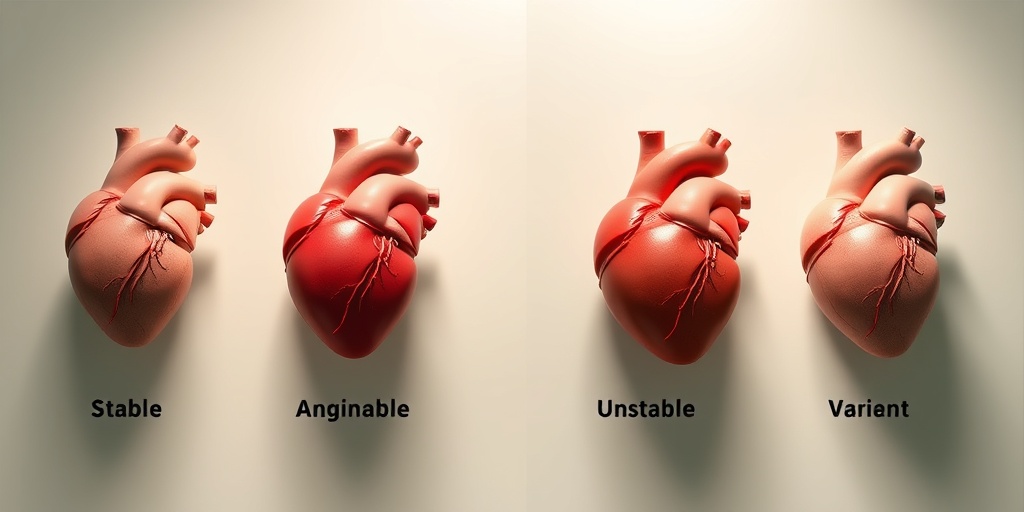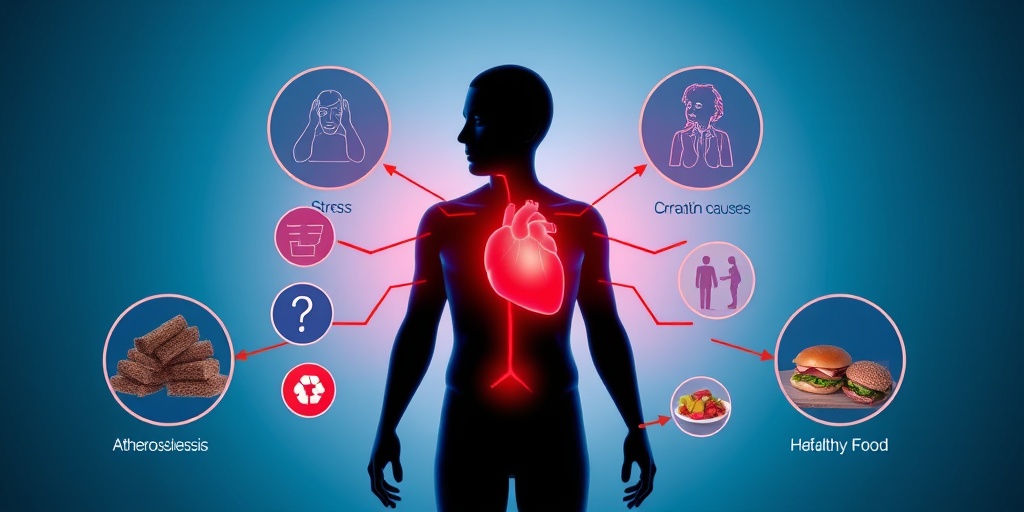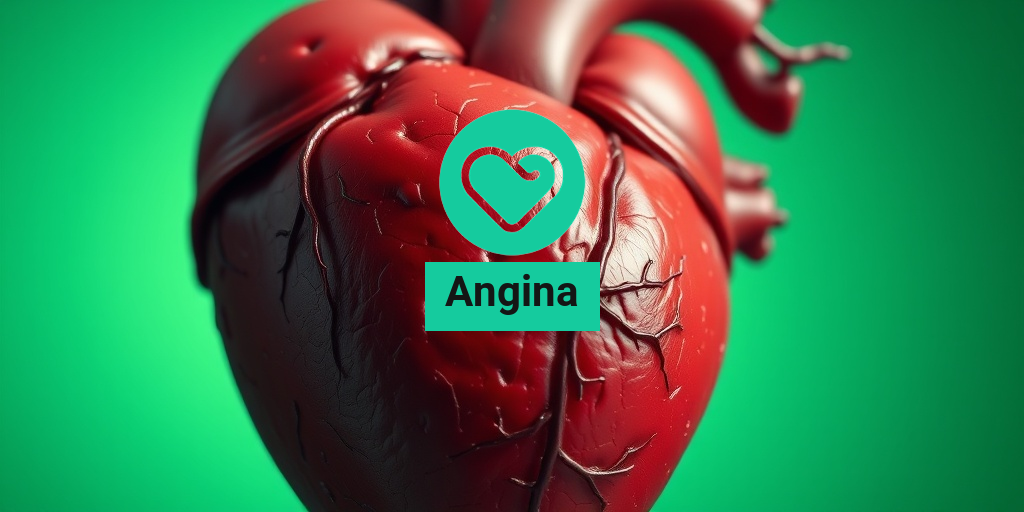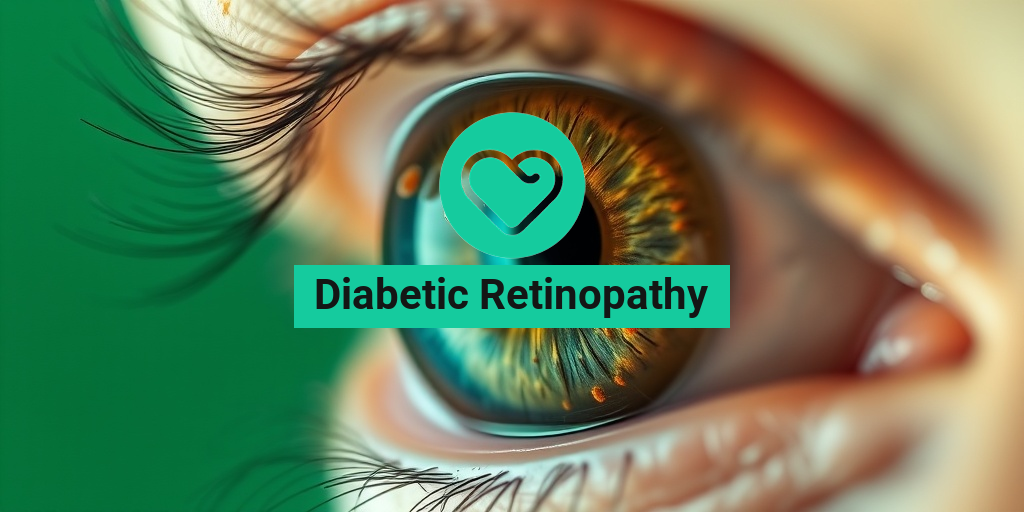What Is Angina?
Angina is a term that refers to chest pain or discomfort that occurs when your heart muscle doesn’t get enough oxygen-rich blood. This condition is often a symptom of coronary artery disease, which is the narrowing of the arteries that supply blood to the heart. Angina can feel like pressure, squeezing, fullness, or pain in the center or left side of your chest. It may also be accompanied by discomfort in your shoulders, neck, arms, back, teeth, or jaw. Understanding angina is crucial for recognizing its symptoms and seeking timely medical intervention.
Understanding the Causes of Angina
The primary cause of angina is reduced blood flow to the heart, often due to:
- Coronary artery disease: The most common cause, where fatty deposits (plaque) build up in the arteries.
- Coronary artery spasm: A temporary tightening of the muscles within the arteries, which can restrict blood flow.
- Other heart conditions: Such as aortic stenosis or hypertrophic cardiomyopathy.
Risk factors for angina include high blood pressure, high cholesterol, smoking, diabetes, obesity, and a sedentary lifestyle. Recognizing these factors can help in managing and preventing angina effectively.
Symptoms of Angina
Angina symptoms can vary from person to person, but common signs include:
- Chest pain or discomfort: Often described as a feeling of pressure or squeezing.
- Pain in other areas: Such as the arms, neck, jaw, or back.
- Shortness of breath: This may occur with or without chest discomfort.
- Nausea or fatigue: Some individuals may experience these symptoms, especially women.
If you experience these symptoms, especially if they are new or different from your usual experience, it’s essential to seek medical advice promptly. Early intervention can prevent more severe heart conditions.
Types of Angina
There are several types of angina, each with distinct characteristics and implications for treatment. Understanding these types can help you identify your symptoms and communicate effectively with your healthcare provider.
Stable Angina
Stable angina is the most common form. It typically occurs during physical exertion or emotional stress and follows a predictable pattern. The discomfort usually lasts a few minutes and is relieved by rest or medication, such as nitroglycerin. This type of angina is often manageable with lifestyle changes and medication.
Unstable Angina
Unstable angina is more serious and unpredictable. It can occur at rest, last longer, and may not be relieved by rest or medication. This type of angina is a medical emergency, as it can signal an impending heart attack. If you experience symptoms of unstable angina, seek immediate medical attention.
Variant Angina (Prinzmetal’s Angina)
Variant angina, also known as Prinzmetal’s angina, is caused by a spasm in the coronary arteries that temporarily reduces blood flow. This type can occur at rest, often during sleep, and is usually relieved by medication. It is less common than stable or unstable angina but can still be serious.
Microvascular Angina
Microvascular angina occurs when the small blood vessels of the heart do not function properly. This type of angina can cause chest pain and discomfort, often in women, and may not be associated with blockages in the larger coronary arteries. Treatment typically focuses on managing symptoms and improving overall heart health.
Understanding the different types of angina is essential for effective management and treatment. If you suspect you have angina or are experiencing any symptoms, consider consulting a healthcare professional for a thorough evaluation and personalized care plan.
For more information on angina and other heart-related conditions, visit Yesil Health AI, a valuable resource for evidence-based health answers. Remember, your heart health is crucial, and staying informed is the first step towards a healthier life! ❤️

Angina Symptoms
Angina is a term that refers to chest pain or discomfort caused by reduced blood flow to the heart. Understanding the symptoms of angina is crucial for early detection and management. Here are the most common symptoms associated with this condition:
1. Chest Pain or Discomfort
The hallmark symptom of angina is a feeling of pressure, squeezing, or fullness in the chest. This sensation can vary in intensity and may last for a few minutes or longer. It’s often described as a heavy weight on the chest, and it may feel similar to heartburn or indigestion.
2. Pain Radiating to Other Areas
Angina pain can radiate beyond the chest. Many individuals report discomfort in the following areas:
- Arms: Often the left arm, but it can affect both.
- Shoulders: A feeling of tightness or pain.
- Neck and Jaw: Discomfort that may mimic dental pain.
- Back: Some may experience pain in the upper back.
3. Shortness of Breath
Alongside chest pain, many people with angina experience shortness of breath. This symptom can occur during physical activity or emotional stress, as the heart struggles to get enough oxygen-rich blood.
4. Nausea and Sweating
Some individuals may feel nauseous or break out in a cold sweat during an angina episode. These symptoms can be alarming and may be mistaken for other conditions, such as a panic attack.
5. Fatigue
Unexplained fatigue, especially during physical exertion, can also be a symptom of angina. If you find yourself feeling unusually tired after activities that were once easy, it’s worth discussing with a healthcare provider.
6. Symptoms Triggered by Activity or Stress
Angina symptoms often arise during physical exertion or emotional stress. Activities such as climbing stairs, heavy lifting, or even intense emotional situations can trigger an episode. Recognizing these triggers can help in managing the condition effectively.
Angina Causes
Understanding the causes of angina is essential for prevention and treatment. Angina is primarily caused by coronary artery disease (CAD), but several factors can contribute to its development:
1. Coronary Artery Disease (CAD)
The most common cause of angina is CAD, where the coronary arteries become narrowed or blocked due to plaque buildup. This restricts blood flow to the heart muscle, leading to angina symptoms.
2. Atherosclerosis
Atherosclerosis is a condition characterized by the hardening and narrowing of the arteries due to cholesterol and fatty deposits. This process can significantly reduce blood flow and is a major contributor to angina.
3. Spasms of the Coronary Arteries
In some cases, angina can occur due to spasms in the coronary arteries, which temporarily reduce blood flow. These spasms can be triggered by factors such as stress, smoking, or the use of certain drugs.
4. Other Risk Factors
Several risk factors can increase the likelihood of developing angina, including:
- High Blood Pressure: Can damage arteries over time.
- High Cholesterol: Contributes to plaque buildup.
- Diabetes: Increases the risk of heart disease.
- Obesity: Linked to various heart conditions.
- Smoking: Damages blood vessels and reduces oxygen in the blood.
- Family History: A genetic predisposition to heart disease can play a role.
5. Lifestyle Factors
Poor lifestyle choices, such as a diet high in saturated fats, lack of physical activity, and excessive alcohol consumption, can contribute to the development of angina. Making healthier choices can significantly reduce the risk.
Recognizing the symptoms and understanding the causes of angina is vital for effective management and treatment. If you experience any of these symptoms, it’s important to consult a healthcare professional for a thorough evaluation and appropriate care. 🩺❤️

Risk Factors for Angina
Angina is a type of chest pain caused by reduced blood flow to the heart. Understanding the risk factors for angina is crucial for prevention and management. Here, we’ll explore the various factors that can increase your likelihood of experiencing angina.
1. Age and Gender
As we age, the risk of developing heart-related issues, including angina, increases. Men are generally at a higher risk at a younger age compared to women. However, after menopause, women’s risk approaches that of men due to hormonal changes.
2. Family History
If you have a family history of heart disease, you may be at a greater risk for angina. Genetics can play a significant role in your susceptibility to heart conditions, making it essential to be aware of your family’s health history.
3. Lifestyle Choices
- Smoking: Tobacco use is a major risk factor for heart disease and angina. It damages blood vessels and reduces oxygen in the blood.
- Poor Diet: A diet high in saturated fats, trans fats, and cholesterol can lead to plaque buildup in the arteries, increasing the risk of angina.
- Lack of Physical Activity: Sedentary lifestyles contribute to obesity and heart disease. Regular exercise is vital for maintaining heart health.
4. Medical Conditions
Several medical conditions can increase your risk of angina:
- High Blood Pressure: Hypertension can damage arteries over time, leading to heart problems.
- Diabetes: This condition can increase the risk of heart disease and angina due to high blood sugar levels damaging blood vessels.
- High Cholesterol: Elevated cholesterol levels can lead to plaque buildup in the arteries, restricting blood flow to the heart.
5. Stress and Mental Health
Chronic stress and mental health issues, such as anxiety and depression, can contribute to heart problems. Stress can lead to unhealthy habits like overeating or smoking, further increasing the risk of angina.
6. Other Factors
Other factors that may contribute to the risk of angina include:
- Obesity: Excess weight can strain the heart and lead to other risk factors like high blood pressure and diabetes.
- Excessive Alcohol Consumption: Drinking too much alcohol can raise blood pressure and contribute to heart disease.
Being aware of these risk factors for angina can help you take proactive steps to protect your heart health. Regular check-ups with your healthcare provider can also aid in early detection and management of potential issues. ❤️
Angina Diagnosis
Diagnosing angina involves a combination of medical history, physical examinations, and diagnostic tests. Understanding the diagnosis process for angina can help you navigate your healthcare journey more effectively.
1. Medical History and Symptoms
Your healthcare provider will begin by taking a detailed medical history. They will ask about:
- Symptoms: Describe your chest pain, including its location, duration, and triggers.
- Family History: Any history of heart disease in your family can be relevant.
- Lifestyle Factors: Discuss your diet, exercise habits, and any smoking or alcohol use.
2. Physical Examination
A thorough physical examination will follow. Your doctor will check your blood pressure, heart rate, and overall health. They may also listen to your heart and lungs for any irregularities.
3. Diagnostic Tests
If angina is suspected, your doctor may recommend several tests to confirm the diagnosis:
- Electrocardiogram (ECG): This test measures the electrical activity of your heart and can identify irregularities.
- Stress Test: This test monitors your heart’s performance under physical stress, often using a treadmill or stationary bike.
- Imaging Tests: Tests like echocardiograms or coronary angiography can provide detailed images of your heart and blood vessels.
4. Blood Tests
Blood tests may also be conducted to check for markers of heart disease, such as cholesterol levels and other substances that indicate heart damage.
Receiving a timely and accurate angina diagnosis is essential for effective treatment and management. If you experience symptoms of angina, don’t hesitate to consult your healthcare provider for a thorough evaluation. 🩺

Angina Treatment Options
Angina is a condition characterized by chest pain or discomfort due to reduced blood flow to the heart. Understanding the various angina treatment options available can empower patients to manage their symptoms effectively and improve their quality of life. Here, we explore the most common treatments for angina, ranging from lifestyle changes to medical interventions.
Lifestyle Changes
Making certain lifestyle adjustments can significantly alleviate angina symptoms. Here are some key changes to consider:
- Diet: A heart-healthy diet rich in fruits, vegetables, whole grains, and lean proteins can help manage angina. Reducing saturated fats, trans fats, and sodium is crucial.
- Exercise: Regular physical activity strengthens the heart and improves circulation. Consult with a healthcare provider to develop a safe exercise plan.
- Weight Management: Maintaining a healthy weight reduces the strain on the heart and can help control angina symptoms.
- Stress Management: Techniques such as yoga, meditation, and deep breathing can help reduce stress, which is a known trigger for angina.
Medications
Several medications are commonly prescribed to manage angina. These include:
- Nitroglycerin: This medication helps to relieve angina pain by relaxing blood vessels and improving blood flow to the heart.
- Beta-blockers: These drugs reduce the heart’s workload and lower blood pressure, which can help prevent angina episodes.
- Calcium Channel Blockers: These medications relax and widen blood vessels, improving blood flow to the heart.
- Antiplatelet Agents: Drugs like aspirin can help prevent blood clots, reducing the risk of heart attacks.
Medical Procedures
In some cases, more invasive treatments may be necessary. These include:
- Angioplasty and Stenting: This procedure involves using a balloon to open blocked arteries and placing a stent to keep them open.
- Coronary Artery Bypass Grafting (CABG): This surgery creates a new pathway for blood to flow to the heart by bypassing blocked arteries.
Each treatment option has its benefits and risks, so it’s essential to discuss these with a healthcare provider to determine the best approach for managing your angina.
Living with Angina
Living with angina can be challenging, but with the right strategies, individuals can lead fulfilling lives. Here are some tips for managing daily life with angina:
Recognizing Symptoms
Understanding the angina symptoms is crucial for effective management. Common symptoms include:
- Chest pain or discomfort, often described as pressure or squeezing
- Pain that may radiate to the shoulders, neck, arms, back, teeth, or jaw
- Shortness of breath
- Nausea or fatigue
Being aware of these symptoms can help individuals seek timely medical attention when necessary.
Creating a Support System
Having a strong support system is vital for those living with angina. Consider the following:
- Family and Friends: Share your condition with loved ones so they can provide emotional support and help you manage triggers.
- Support Groups: Joining a support group can connect you with others who understand your experiences and challenges.
Monitoring Your Condition
Regular check-ups with a healthcare provider are essential for monitoring your heart health. Keeping track of your symptoms, medication adherence, and lifestyle changes can help you and your doctor make informed decisions about your treatment plan.
Emergency Preparedness
It’s important to be prepared for potential angina attacks. Here are some steps to take:
- Know When to Seek Help: If angina symptoms worsen or do not improve with rest or medication, seek emergency medical assistance.
- Carry Medication: Always have your nitroglycerin or other prescribed medications on hand in case of an angina episode.
By understanding your condition and implementing effective management strategies, living with angina can become more manageable, allowing you to focus on enjoying life. 🌟

Frequently Asked Questions about Angina
What is Angina?
Angina is a type of chest pain caused by reduced blood flow to the heart. It often feels like pressure or squeezing in the chest and can be triggered by physical activity or stress.
What are the symptoms of Angina Pectoris?
The symptoms of angina pectoris can include:
- Chest pain or discomfort
- Pain in the shoulders, neck, arms, back, teeth, or jaw
- Shortness of breath
- Nausea or fatigue
How is Angina Diagnosed?
Doctors typically diagnose angina through a combination of medical history, physical examination, and tests such as:
- Electrocardiogram (ECG)
- Stress tests
- Blood tests
- Coronary angiography
What are the different types of Angina?
There are several types of angina, including:
- Stable Angina: Predictable and occurs with exertion.
- Unstable Angina: Unexpected and may occur at rest; requires immediate medical attention.
- Variant Angina: Caused by spasms in the coronary arteries.
Can Angina be treated?
Yes, angina can be managed through lifestyle changes, medications, and in some cases, surgical procedures. Common treatments include:
- Medications such as nitrates, beta-blockers, and statins
- Coronary angioplasty and stenting
- Coronary artery bypass grafting (CABG)
When should I seek medical help for Angina?
If you experience severe chest pain, especially if it lasts more than a few minutes or is accompanied by other symptoms like shortness of breath, seek emergency medical help immediately. 🚑
Is Angina a serious condition?
Angina itself is not a heart attack, but it is a warning sign that you are at risk for heart disease. It is important to take it seriously and consult a healthcare provider for proper management.
Can lifestyle changes help with Angina?
Absolutely! Making lifestyle changes such as:
- Eating a heart-healthy diet
- Exercising regularly
- Quitting smoking
- Managing stress
can significantly improve your heart health and reduce the frequency of angina episodes.
What is the difference between Angina and a Heart Attack?
Angina is a symptom of heart disease, while a heart attack occurs when blood flow to the heart is blocked for an extended period. If you experience sudden, severe chest pain, it may indicate a heart attack, and you should seek emergency help immediately.




